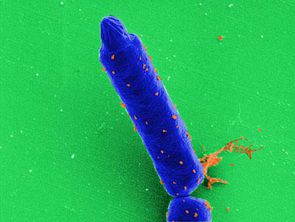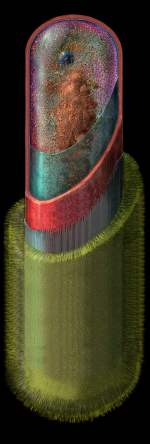Bacillus Anthracis NEU2011
Higher Order Taxa
Domain: Bacteria Phylum: Firmicutes Class: Bacilli Order: Bacillales Family: Bacillaceae Genus: Bacillus Species: Bacillus anthracis (Cohn 1872)
Description and significance
Bacillus Anthracis is a rod shaped bacteria with a width of 1-1.2 um and a length of 3-5 um. It can be grown in an ordinary nutrient broth, under either aerobic or anaerobic conditions. It was one of the first organisms to be proven to show disease, by Robert Koch. Bacillus Anthracis is similar in size, morphology, and spore formation with Bacillus cereus, and Bacillus thuringiensis.It is gram positive and is able to form spores. These spores are highly resistant and are able to sustain drastic changes in temperature, low nutrient environments, and application of harsh chemicals (including disinfectant chemicals such as 95% ethanol) over many years. Because the spores are so resilient, it is often hard to control this bacteria.
Bacillus Anthracis is pathogenic and is associated with the disease Anthrax. Anthrax is mostly obtained by livestock, such as cattle, goats and sheep. This is because the bacteria in the soil often form spores, which last for many years. Then an animal comes along, grazing on the grass where the spore is located and ingests the spore. Once in the body, the spore germinates and begins to grow and divide. Humans can obtain three different types of anthrax, intestional anthrax, cutaneous anthrax, and inhalation anthrax.
Genome Structure
There are currently 6 sequencing projects in progress and 5 complete genomes for the Bacillus anthracis bacteria. The complete genome sequence was first obtained using whole-genome shotgun sequencing. Bacillus anthracis has one chromosome and its genome is 5.5 Mb in size. The chromosome contains 5,227,419 base pairs. Its virulence factors are encoded on two plasmids, pXO1 (anthrax toxin, 181,677-bp) and pXO2 (capsule genes, 94,830-bp). (Ravel 445)
Cell Structure and Metabolism
Bacillus anthracis is a gram positive bacteria this means the bacteria has a very thick peptidoglycan layer then the periplasmic space between the peptidoglycan and the cell membrane. It also has a protective capsule composed of poly-D-glutamic acid, which because of its negative charge protects the bacteria from phagocytosis of macrophages (a cell of the bodies immune system). When looking under a microscope, it is rod shaped like all bacteria in the Bacillus genus, but has distinctive squared ends and often presents in small chains. [[Image:B._anthracis_spore.jpg|thumb|295px|right|alt=A Bacillus Anthracis|]
Pathology
Cell Ecology
Overall paper length should be 3,000 words, with at least 3 figures.
References
Todar, Kenneth. "Bacillus Anthracis and Anthrax." Online Textbook of Bacteriology, 2011. Web. Feb. 2011. <http://www.textbookofbacteriology.net/Anthrax.html>.
Gardner, Roberta. "Anthrax (Bacillus Anthracis)." CSA. ProQuest, 2011. Web. Feb. 2011. <http://www.csa.com/discoveryguides/anthrax/overview.php>.
Takai, K., Sugai, A., Itoh, T., and Horikoshi, K. "Palaeococcus ferrophilus gen. nov., sp. nov., a barophilic, hyperthermophilic archaeon from a deep-sea hydrothermal vent chimney". International Journal of Systematic and Evolutionary Microbiology. 2000. Volume 50. p. 489-500.
Edited by student of Joan Slonczewski for BIOL 238 Microbiology, 2009, Kenyon College.
Category: Pages edited by students of Joan Slonczewski at Kenyon College


